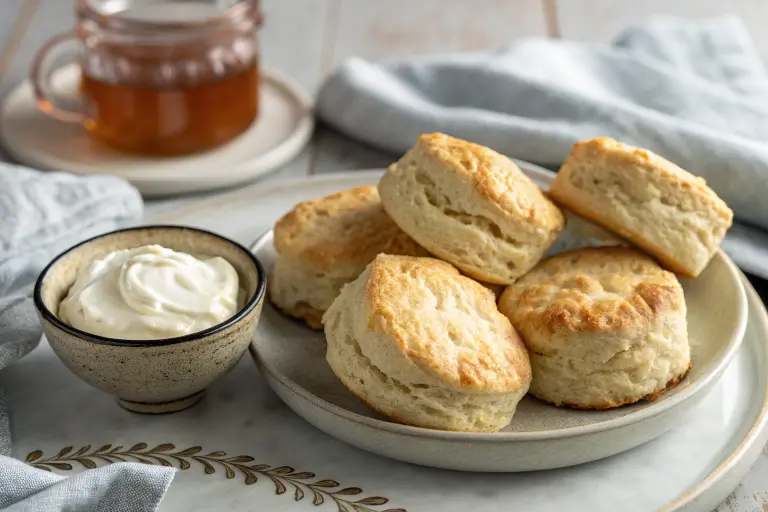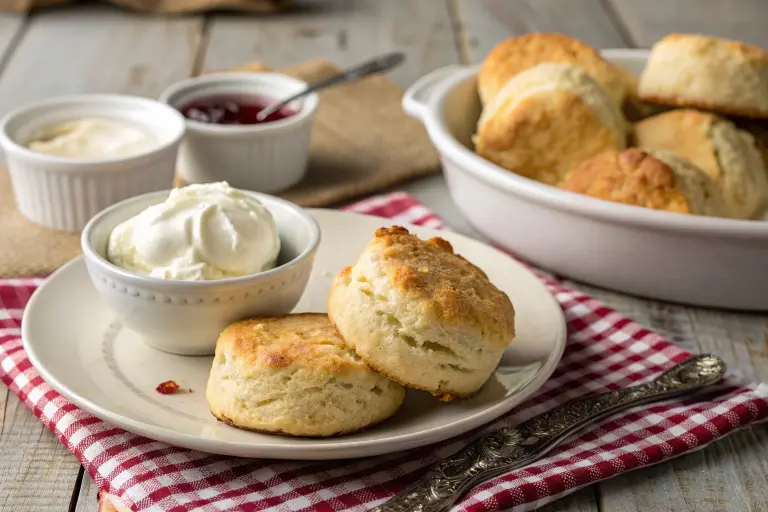Have you ever found yourself in the middle of preparing a recipe that calls for a Bisquick, only to realize you’re out of it? It’s a frustrating moment, but fortunately, what can I use if I don’t have Bisquick? is a question with many answers. Bisquick is a versatile ingredient commonly used in everything from pancakes and waffles to biscuits and dumplings, thanks to its pre-mixed blend of flour, baking powder, salt, and fat. However, there’s no need to panic when you don’t have it on hand. Whether you’re looking for a homemade solution or a pantry staple substitute, there are several ways to recreate the convenience of Bisquick in your kitchen.
In this guide, we’ll answer the important question, “What can I use if I don’t have Bisquick?” by discovering various alternatives that you can easily prepare or find at the store. From simple DIY versions to specialized gluten-free substitutes, we’ll cover all the options to help you get the same fluffy, tender results in your recipes. Plus, we’ll provide tips on adjusting for texture and flavor, so you can continue making your favorite dishes easily, even without Bisquick.
So, let’s dive in and discover how to turn your kitchen into a Bisquick-free zone without compromising taste!
What Is Bisquick?
Before we dive into alternatives, it’s important to understand what Bisquick is. Bisquick is a pre-mixed flour blend that includes flour, shortening, baking powder, and salt. It’s primarily used for making quick recipes like pancakes, waffles, biscuits, and muffins, offering convenience and consistency.
However, if you don’t have it on hand, plenty of alternatives can do the trick, often with ingredients you already have in your kitchen.
Why Might You Need a Bisquick Substitute?
There are a few common reasons you might ask, “What can I use if I don’t have Bisquick?”
- Running out of Bisquick: Maybe you’ve made too many pancakes or waffles and have used up your last box.
- Dietary restrictions: You may have allergies or dietary preferences that Bisquick doesn’t meet, like gluten intolerance or veganism.
- Availability: Not everyone can access store-bought Bisquick, and you might want to try making your own blend.
No matter the reason, this guide will provide you with reliable substitutes for Bisquick that work well in almost any recipe.

Common Bisquick Substitutes
1. DIY Bisquick Substitute: Flour, Baking Powder, and Shortening
If you’re wondering, “What can I use if I don’t have Bisquick?” you can easily create a substitute with ingredients that are likely already in your pantry. Here’s how you can make your own Bisquick mix:
Ingredients:
- 1 cup of all-purpose flour
- 1 1/2 teaspoons of baking powder
- 1 tablespoon of vegetable oil or shortening
- A pinch of salt
Instructions:
- Combine the flour, baking powder, and salt in a mixing bowl.
- Cut in the shortening or vegetable oil using a pastry cutter or your fingers until the mixture resembles coarse crumbs.
- Store in an airtight container until you’re ready to use it.
This mixture will work just as well as the store-bought version for most recipes that require Bisquick, including pancakes, biscuits, and even cobblers.
2. Self-Rising Flour
If you already have self-rising flour in your pantry, you have an easy substitute. This flour type already contains baking powder and salt, making it a good replacement for Bisquick. However, you may need to add fat (like butter or vegetable oil) to match the consistency and texture of Bisquick.
How to use it:
- Use 1 cup of self-rising flour for each cup of Bisquick, then add 1 tablespoon of butter or shortening.
This is a quick and simple solution for recipes like biscuits and pancakes where you need a leavening agent and flour.
3. All-purpose flour and Baking Powder
Sometimes, all-purpose flour and baking powder can act as a Bisquick substitute. For now, you can skip the shortening or oil if you don’t need it for the recipe, but adding a small amount of fat can help improve texture.
How to use it:
- For 1 cup of Bisquick, mix 1 cup of all-purpose flour with 1 1/2 teaspoons of baking powder and a pinch of salt.
This combination works well in most recipes that require the rising properties of Bisquick.
4. Gluten-Free Bisquick Substitutes
For those who need a gluten-free alternative, there are a few options to try. Many brands make gluten-free flour blends, often containing rice flour, potato starch, and cornstarch.
Substitute with gluten-free flour:
- Use 1 cup of gluten-free all-purpose flour.
- Add 1 1/2 teaspoons of baking powder and a pinch of salt.
This is a great substitute for those with celiac disease or gluten sensitivity and can be used in most recipes that require Bisquick.
5. Cornstarch and Baking Powder
If you have cornstarch and baking powder on hand, you can quickly make a Bisquick-like mixture. Cornstarch helps provide the necessary texture, while the baking powder ensures the dough rises.
How to use it:
- Combine 1 cup of cornstarch, 1 1/2 teaspoons of baking powder, and a pinch of salt.
- Add fat (like vegetable oil) as needed to create the desired consistency.
This can be particularly useful for making doughs and batters that need to hold together and rise.
Tips for Using Substitutes in Recipes
When asking, “What can I use if I don’t have Bisquick?” it’s important to consider how these substitutes will affect the final dish. Here are a few tips to keep in mind:
- Texture: Bisquick provides a soft, slightly crumbly texture in recipes like biscuits. If your substitute lacks that, adding a bit of fat (butter, shortening, or oil) will help.
- Flavor: The flavor of Bisquick is quite neutral, so most substitutes will not alter the taste significantly. However, if you are using gluten-free flour, some blends may have a stronger flavor that might affect the outcome.
- Quantity: Always measure the substitute properly. For example, gluten-free flour may behave differently than regular flour so that adjustments might be needed.
Additional Ingredients You Can Use Instead of Bisquick
While the substitutes mentioned above are the most common, there are other ingredients that can also serve as replacements for Bisquick in certain situations. Some of these might work better, depending on your recipe.
1. Oats or Oat Flour
Oats can be an excellent substitute if you’re looking for a healthier alternative. Oat flour (ground oats) can replace Bisquick in many recipes, offering a higher fiber content and a slightly nutty flavor.
How to use it:
- Use 1 cup of oat flour for every 1 cup of Bisquick. Add baking powder and salt as needed.
2. Coconut Flour
Coconut flour can be a great substitute for those following a low-carb or keto diet. Coconut flour is highly absorbent, so you’ll need to adjust the amount of liquid in your recipe.
How to use it:
- Use 1/4 cup of coconut flour for every cup of Bisquick.
- Add extra liquid to prevent the batter or dough from becoming too dry.
3. Almond Flour
Almond flour can also serve as a low-carb alternative to Bisquick. It’s made from finely ground almonds and adds a slightly sweet, nutty flavor to baked goods.
How to use it:
- Use 1 cup of almond flour for every 1 cup of Bisquick, but be prepared to adjust the baking time since almond flour can brown faster than all-purpose flour.
4. Whole Wheat Flour
It can work as a substitute if you have whole wheat flour on hand and want a healthier alternative. Whole wheat flour provides more fiber and nutrients compared to refined white flour.
How to use it:
- Replace Bisquick in a 1:1 ratio with whole wheat flour.
- Add extra baking powder and salt for the right consistency.
Common Bisquick Recipes and How to Replace It
If you’re in the middle of making a classic Bisquick recipe, here are some popular options and how to swap in your homemade or store-bought Bisquick substitute:
1. Biscuits
For biscuits, Bisquick provides the perfect texture with a soft, flaky crumb. To replicate this, mix all-purpose flour, baking powder, salt, and shortening or butter.
Quick Recipe:
- Combine 2 cups of flour, 3 teaspoons of baking powder, 1 teaspoon of salt, and 1/4 cup of shortening.
- Add 1/2 cup of milk and stir until just combined.
2. Pancakes
Pancakes made with Bisquick are light and fluffy. To create a similar texture, you must use a substitute that includes a leavening agent like baking powder.
Quick Recipe:
- Mix 1 cup of flour, 1 teaspoon of baking powder, 1 tablespoon of sugar, and a pinch of salt.
- Add 3/4 cup of milk, 1 egg, and 1 tablespoon of melted butter.
3. Waffles
For waffles, the same principles apply. Use a mix of flour, baking powder, and fat to get the right consistency.
Quick Recipe:
- Combine 1 1/2 cups of flour, 2 teaspoons of baking powder, 1/4 teaspoon of salt, and 1/4 cup of sugar.
- Add 1 cup of milk, 1 egg, and 1/4 cup of melted butter.
4. Muffins
When making muffins, Bisquick creates a fluffy, moist texture. Using a substitute of all-purpose flour with a leavening agent should give you the same results.
Quick Recipe:
- Mix 2 cups of flour, 3 teaspoons of baking powder, and a pinch of salt.
- Add 1 cup of milk, 1 egg, and 1/4 cup of melted butter or oil.

FAQs: What Can I Use if I Don’t Have Bisquick?
❓ Can I substitute Bisquick for flour?
Yes, you can substitute a Bisquick for flour in most recipes. However, you’ll need to adjust for the added baking powder, salt, and fat that Bisquick contains. Typically, for every 1 cup of Bisquick, use 1 cup of flour plus 1 1/2 teaspoons of baking powder and a pinch of salt.
❓ Can I use regular pancake mix instead of Bisquick?
Yes, you can use regular pancake mix as a substitute for a Bisquick. Both products are similar, but pancake mix may contain slightly more sugar. You may want to reduce the sugar in your recipe if using pancake mix.
❓ Is Bisquick just flour and baking powder?
While a Bisquick contains flour and baking powder, it also includes salt and shortening (or another fat). The fat gives Bisquick its convenience, as it eliminates the need for adding separate fats in recipes.
❓ What is a substitute for Bisquick?
You can substitute a Bisquick with a variety of ingredients such as self-rising flour, a DIY blend of all-purpose flour, baking powder, and fat, or even gluten-free flour blends depending on your dietary needs.
Conclusion: What Can I Use if I Don’t Have Bisquick?
So, what can I use if I don’t have Bisquick? Whether you’re missing it unexpectedly or simply prefer to skip the store-bought version, many great substitutes can help you create delicious dishes without compromising texture or flavor. From DIY blends of flour, baking powder, and fat to self-rising flour or even gluten-free options, you have plenty of choices that will work for everything from pancakes and waffles to muffins and biscuits. The key is understanding a Bisquick’s role in your recipe and choosing a substitute that closely mimics its properties.
Now that you’re equipped with the knowledge to replace a Bisquick, why not try your hand at some new recipes? For example, if you’re in the mood for a simple dessert, you can check out our 3-Ingredient No-Bake Cheesecake, which requires no special ingredients. Or, if you’re looking for a healthier breakfast option, our Vegan Banana Pancakes are a great choice for those who want a delicious, plant-based alternative.
Don’t forget to visit our platform’s links to Chaynez Recipes for the latest updates, popular recipes, and cooking tips. Stay inspired and keep experimenting in the kitchen!






